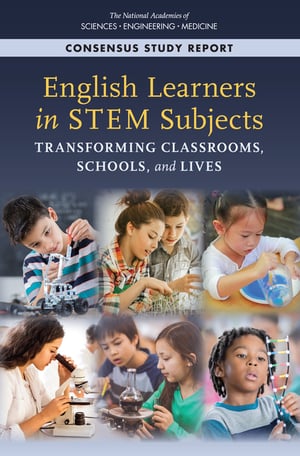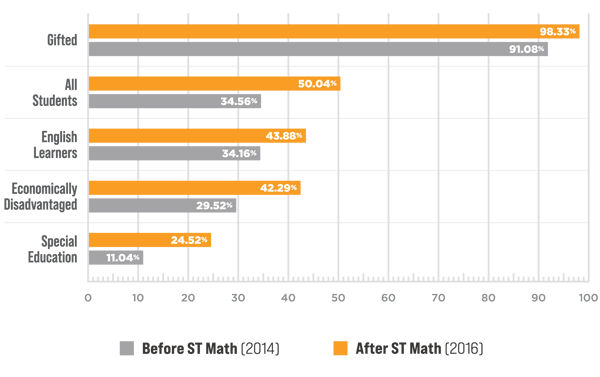
 The National Academies of Sciences, Engineering and Medicine released a consensus study report in October 2018 entitled English Learners in STEM Subjects: Transforming Classrooms, Schools, and Lives. The report took a look at existing research on the teaching, learning and assessment of English Learners (ELs), and made recommendations for improving science, technology, engineering and math (STEM) learning experiences and opportunities for ELs, as well as continued research.
The National Academies of Sciences, Engineering and Medicine released a consensus study report in October 2018 entitled English Learners in STEM Subjects: Transforming Classrooms, Schools, and Lives. The report took a look at existing research on the teaching, learning and assessment of English Learners (ELs), and made recommendations for improving science, technology, engineering and math (STEM) learning experiences and opportunities for ELs, as well as continued research.
In highlighting the underrepresentation of ELs in college STEM programs, as well as the STEM workforce itself, the report concluded “systemic reform is needed to ensure that ELs receive equitable opportunities to engage in STEM subjects.”
When it comes to math education, ELs are facing additional challenges in a system that is already broken. We are already in a math crisis in the US. Less than half of 4th grade students in this country are proficient in math, and by the time they reach 8th grade, only one third are proficient.
So how do we improve math education overall, and do it in a way that’s equitable for ELs and all students? Look at addressing the experience gap.
One of the core findings of the English Learners in STEM report noted that STEM subjects lend themselves to different learning experiences:
“STEM subjects afford opportunities for alternate routes to knowledge acquisition (i.e., experimentation, demonstration of phenomena, and demonstration of practices) through which students can gain a sense of STEM content without resorting predominantly to language to access meaning—it is through this experience that language is also learned.”
While it is true that STEM subjects seem tailor-made for rich and varied learning experiences, those types of experiences are often severely lacking when it comes to mathematics. Examples of creative experimentation and rich, hands-on activities with science, technology and engineering are easy to imagine, but what about math?
Math is very often taught in a way that focuses on calculations and rote memorization. As a result, many students have a poor relationship with math, as they have only experienced it in a very limited way. Which contributes to the aforementioned crisis.
All students, regardless of language proficiency level, have the ability to think deeply about mathematical concepts. However, when math is presented only as words and numbers on a page, English learners can miss out on crucial opportunities to understand the meaning behind the math.
One of the report’s recommendations spoke of a need to “develop high-quality science, technology, engineering, and mathematics (STEM) curricular materials and integrate formative assessment into classroom practice to both facilitate and assess English learners’ (ELs’) progress through the curriculum.”
One program already accomplishing this is MIND Research Institute’s ST Math program.
ST Math—created by neuroscientists, mathematicians and educational innovators at MIND Research Institute—is a visual instructional program that leverages the brain's innate spatial-temporal reasoning ability to solve mathematical problems. Students are able to see abstract math concepts through graphically-rich visual models and real-time informative feedback. ST Math’s rigorous puzzles facilitate students' in action-oriented learning, which increases problem-solving skills. Students work through the mastery-based, standards-aligned curriculum at their own pace; meanwhile the teacher monitors progress, facilitates students who are struggling, and utilizes the digital manipulatives from the software in class lessons.
With ST Math, students experience math in a totally different way. This learning experience has a proven positive effect on English learners, and the results have been seen time and time again across the country.
A study of 21,000 students in Killeen, Texas showed that ELs—and all students—showed increased proficiency with ST Math:
 Clay Spring Elementary in Florida saw a 17% increase in EL math proficiency over one year:
Clay Spring Elementary in Florida saw a 17% increase in EL math proficiency over one year:

You can read more about the growth in proficiency ELs are experiencing across the country here, and see how ST Math is impacting all students on our Results at Scale page.
One of the greatest opportunities we have in working to address the math crisis in this country is that we can build solutions that are inherently equitable. By creating learning experiences that provide access to more students, remove unnecessary barriers and focus on how students learn, we can improve math education for everyone.
As we continue to explore solutions that bridge the experience gap for math students, we can build in equitable access from the very start. These solutions by their nature are created for all students, where EL-accessible content is not an adaptation or add-on. In future blogs, we’ll be looking at more of the recommendations from the English Learners in STEM Subjects report, and discussing how MIND is working to close the experience gap outside the classroom as well.

Brian LeTendre was the Director of Impact Advancement at MIND Research Institute. In addition to building thought leadership and brand awareness for MIND, Brian worked cross-functionally internally and externally to amplify MIND's social impact and accelerate our mission. He is an author, podcaster and avid gamer.
Comment